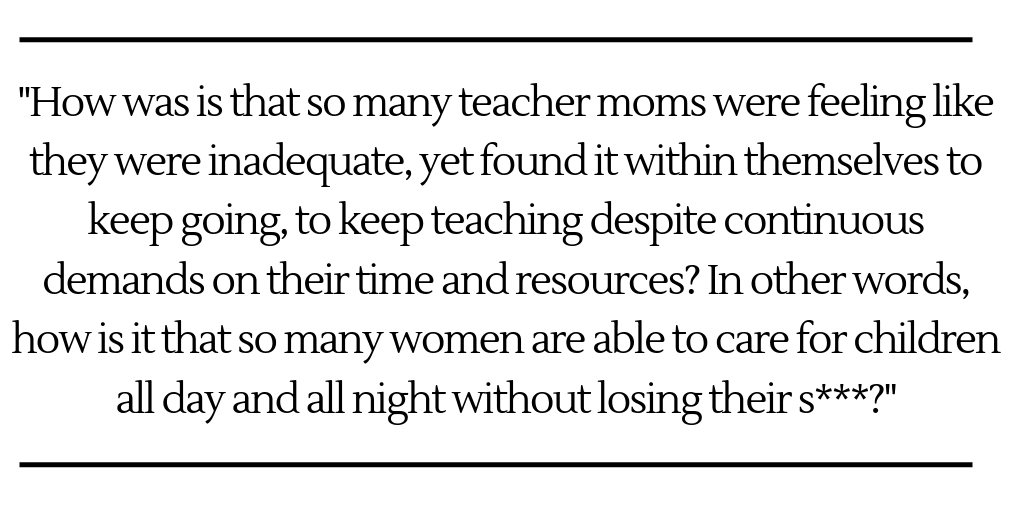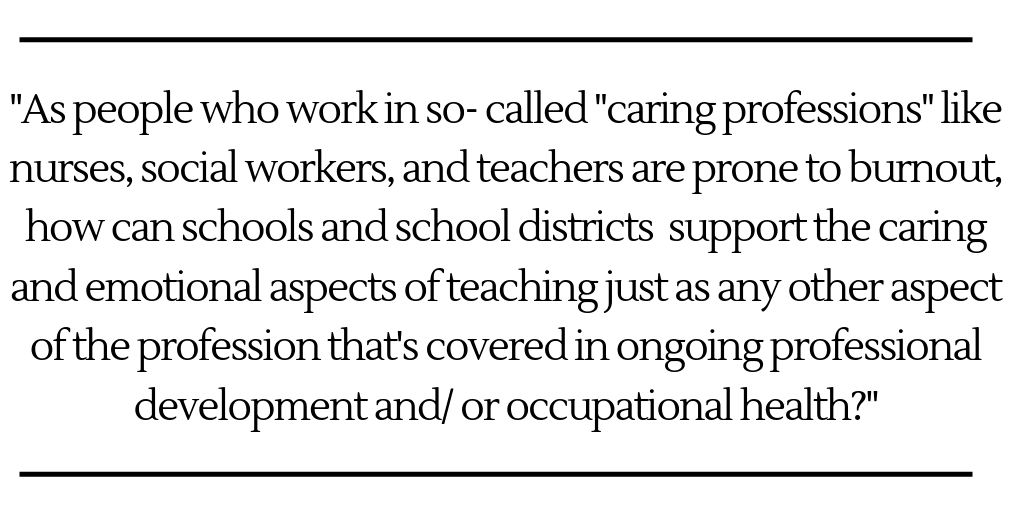The Life of Teacher Moms
Why the realities of being both teacher and mom pushed me to become a researcher
This blog post is part of a two-part series on teacher moms.
Ready for Part 2? Continue here.
Upon coming to the end of my maternity leave after having my first child, I found myself torn between my love for teaching and my desire to be there for my newborn son. I had set my aspirations on obtaining a new teaching position close to home and in my hometown, which eventually narrowed me down to two choices: pursue a part-time continuing contract in my preferred teaching area (secondary science), or a full-time continuing contract in a less preferred yet still enticing subject.
I DEBATED TEACHING PART-TIME TO MEET THE DEMANDS OF BEING A MOTHER AND A TEACHER

The decision seemed pretty obvious at first—what early career teacher would turn down a full-time continuing contract in her hometown, especially in a large school district the size of New Brunswick? I remember going to a colleague’s retirement party and excitedly telling people how I would be taking on this new, full-time adventure in the same school where I had completed my teaching practicum only three years earlier. Yet someone at the party suggested that I might be better off taking the part-time gig to allow me extra time with my new baby boy. From that moment forward, a seed had been planted that got me thinking about my long-term professional goals and how this could fit alongside the demands of motherhood. The year I’d spent at home with my son was indeed gratifying and wonderful in many ways, yet at the same time I didn’t find it stimulating to be home alone all day while my husband was out working. I left the house regularly and had a great circle of friends, yet I missed teaching and having conversations with my colleagues about the ups and downs of teaching.

I eventually took the leap and decided to take the part-time job. It probably had something to do with the chronic scarcity of available childcare spots, or the enticement of being able to teach science all the time. Or, maybe that friend at the party had an influence on me. Whatever the reason, I was fortunate enough to be able to choose to teach a full slate of science courses part-time at the school district’s adult education centre for the next seven years. The decision to take on this “smaller” job is something I’ve never regretted.
I WAS HUNGRY TO LEARN MORE ABOUT TEACHER MOMS AND HOW THEY SEEMINGLY “DO IT ALL”

Ultimately, this experience of choosing between my family and my professional goals brought about some fundamental shifts in how I viewed my career. I had an aching desire to dig deeper, which led me to pursue Ph.D. research into the lived experiences of women who were simultaneously teaching and raising children of their own. Working part-time and in a setting that didn’t require the immense prep work and grading that are typically part of a teacher’s workload, I was able to leave work at work and spend my time at home being truly present with my son and — three years later — with my youngest daughter. I was also fortunate enough to have the opportunity and security, thanks to my husband’s work, to work part-time. Yet, even without the additional strain of a “typical” teaching job, I nevertheless found it stressful and exhausting to meet the demands of my family.
So I seriously wondered: How are teacher moms who are working full-time hours able to work with children all day and then come home to once again “work with” their own children (in different but no less challenging ways) — without getting overwhelmed by it all? And, on the flipside: How are female teachers without children managing their work responsibilities, and do they have different demands to attend to?

I began having conversations with colleagues at our children’s birthday parties to see if I could identify any common themes in how these women, who were seemingly “doing it all,” were able to stay afloat. All of my teacher friends seemed to feel that they were neither working nor parenting to the best of their abilities. They felt like they were “sucking at everything all the time” and that they were likely the only ones having this experience, yet they continued to be able to somehow continue on in their multiple roles. How was it that so many teacher moms were feeling like they were inadequate, yet found it within themselves to keep going, to keep teaching despite continuous demands on their time and resources? In other words, how is it that so many women are able to care for children all day and all night without losing their s***?

I REALIZED THERE’S A LOT TO LEARN FROM FEMALE TEACHERS ABOUT RESILIENCE — AND MUCH MORE WE CAN DO TO SUPPORT THEM AT SCHOOL
I used my research to look at whether there are any differences between the stress levels, resilience strategies, and work-life equilibrium routines (i.e. being able to meet demands at work and at home) of teacher moms versus female teachers without kids. The simple verdict — not really. It turns out that maintaining your well-being as a teacher requires similar strategies regardless of whether or not you’re a parent. In fact, teachers’ well-being seems to depend on things like maintaining healthy relationships, keeping perspective, and taking part in healthy activities like regular exercise.
But I’m still left with larger questions about working conditions and demands under which teachers continue to operate:
- As people who work in so-called “caring professions” like nurses, social workers, and teachers are prone to burnout, how can schools and school districts support the caring and emotional aspects of teaching just as any other aspect of the profession that’s covered in ongoing professional development and/or occupational health?
- What can school systems do to help support teacher well-being at a systemic level through things like policies, continuous professional development, and district-wide action plans, so that we’re not putting full responsibility on teachers to sustain their own well-being?
I hope that by sparking and engaging in discussions around these questions, we might one day better recognize and support teachers’ work-life equilibrium.
This blog post is part of a two-part series on teacher moms.
Ready for Part 2? Continue here.
Dr. Shirley Giroux’s Ph.D. dissertation is entitled, “Like Being Pecked to Death by a Chicken: Resilience and Work-Family Equilibrium in Teacher/Mothers.” Check out a recap on her research here.
Author note: All of the teachers who participated in my research self-identified as cisgender female. Except for limiting my sample to female teachers, this lack of diversity was not intentional
Photos: Adobe Stock
